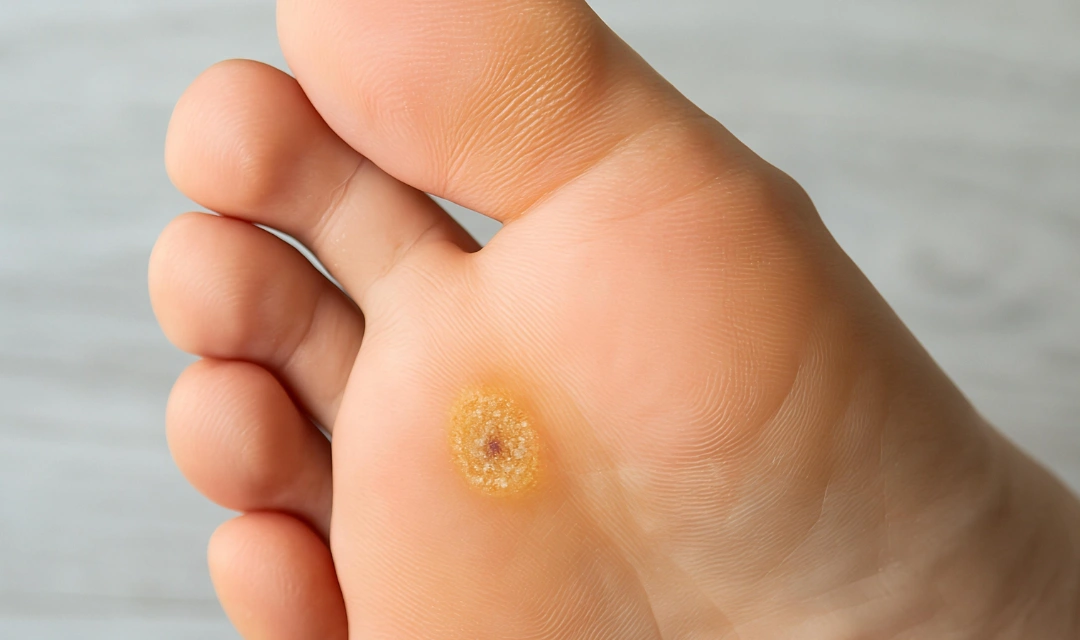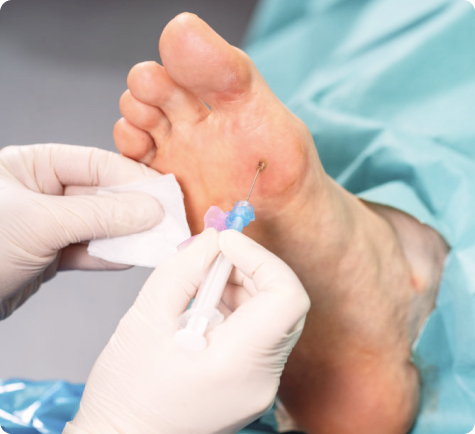What are plantar warts?
Plantar warts are small, rough skin growths that appear on the soles of the feet. They are often round, grainy and may have tiny black dots in the centre, which are clotted blood vessels. Because they form on weight-bearing areas such as the heel or ball of the foot, they can feel tender or painful when standing or walking. Warts may appear as a single lesion or develop in clusters, known as mosaic warts.

What causes plantar warts?
Plantar warts are caused by the human papillomavirus (HPV), which enters the skin through tiny cuts, cracks or weakened spots. The virus is highly opportunistic and thrives in environments where the skin is exposed to moisture or friction.
Common causes and contributing factors include:
- Walking barefoot in communal areas such as pools, gyms and public showers
- Minor cuts or cracked skin that allow the virus to enter
- Excessive moisture from sweaty feet or tight footwear
- Weakened skin barrier due to pressure or rubbing
- Lowered immunity, which reduces the body’s ability to fight off viral infections
Understanding how plantar warts develop helps guide both treatment and prevention, especially for individuals who spend time in shared or humid environments.
What happens if plantar warts are left untreated?
Plantar warts may seem harmless at first, but they rarely go away quickly on their own. Without proper treatment, the virus can become more established in the skin and lead to ongoing discomfort.
Common issues that develop over time include:
- Warts spreading or multiplying, especially on nearby areas of the foot
- Deepening of the wart into the skin, making it more painful and harder to treat
- Persistent pain or pressure when standing, walking or exercising
- Changes in gait as you unconsciously shift weight to avoid discomfort
- Larger mosaic clusters, which are more resistant to over-the-counter remedies
Early podiatry treatment helps control the virus, reduce pain and prevent the wart from returning or leaving behind thick, scarred skin.
When should you see a podiatrist for wart removal?
You should seek podiatry care when a plantar wart becomes painful, stubborn, or begins to affect daily activities. Professional treatment is especially important when the wart does not respond to over-the-counter remedies or continues to grow.
Signs that you should see a podiatrist include:
- Persistent pain or tenderness when walking or standing
- Thickened or hardened skin over the wart
- Warts that spread or form clusters (mosaic warts)
- Failure of over-the-counter remedies after several weeks
- A wart that bleeds, changes appearance or becomes increasingly uncomfortable
- Presence of medical conditions such as diabetes or poor circulation, where self-treatment is not advisable
Getting help early improves comfort, shortens recovery time and makes treatment more effective.
What professional treatments are available for plantar warts?
Plantar warts can be stubborn, especially when they sit deep under pressure points on the foot. At Atlas Podiatry, several treatment options are available, and the choice depends on the size, depth, number of warts and your comfort level with each method. All treatments aim to remove the infected tissue and stimulate the body’s natural response to clear the virus.
- Cryotherapy — Cryotherapy is a common method for wart removal that uses liquid nitrogen to freeze the wart. The cold temperature creates a controlled blister beneath the infected skin, allowing the wart to gradually lift away as the tissue sheds. This process helps stimulate the body’s immune response to the virus. Several sessions are usually needed, and mild blistering or tenderness may occur for a day or two after each visit.
- Swift® Microwave Therapy — this is an advanced technique and Atlas Podiatry is the first clinic in Asia to adopt this technology. Swift® delivers short bursts of microwave energy directly into the wart tissue, creating a rapid heat response that alerts the immune system to target the HPV virus. The procedure is quick, clean and non-invasive. Most patients can return to normal activities straight after the session.
- Wart needling — this is particularly used for deeper or longstanding verrucae. Performed under local anaesthesia, the podiatrist gently punctures the wart multiple times with a fine, sterile needle. This introduces the viral tissue into deeper layers of the skin where the immune system can mount a more effective response. Over the following weeks, the body gradually works to clear the wart, and surrounding warts may improve as well.
All three treatments are carried out under sterile conditions by trained podiatrists. Your podiatrist will recommend the most appropriate method based on the type of wart, your skin’s response and your overall comfort.


How long does wart removal take?
The duration of wart removal varies from person to person, as it depends on the size of the wart, how deep it is and how your body responds to treatment. Most plantar warts do not disappear immediately and require a series of appointments to achieve full clearance.
Many patients need several sessions, regardless of whether cryotherapy, Swift® therapy, or wart needling is used. Improvement usually occurs gradually as the immune system clears the viral infection and healthy skin replaces the affected area. Regular follow-up visits help the podiatrist monitor progress and adjust the treatment plan if needed.
How long does wart removal take?
The duration of wart removal varies from person to person, as it depends on the size of the wart, how deep it is and how your body responds to treatment. Most plantar warts do not disappear immediately and require a series of appointments to achieve full clearance.
Many patients need several sessions, regardless of whether cryotherapy, Swift® therapy, or wart needling is used. Improvement usually occurs gradually as the immune system clears the viral infection and healthy skin replaces the affected area. Regular follow-up visits help the podiatrist monitor progress and adjust the treatment plan if needed.

What can you expect after a wart treatment?
After a session, the recovery experience will vary slightly depending on the method used. Treatments such as cryotherapy, wart needling and Swift® Microwave Therapy may cause mild to moderate tenderness, redness or blistering at the treated area. These reactions are expected and indicate that the skin is responding to the treatment. Any discomfort or blister formation typically settles within a few days.
Regardless of the method used, your podiatrist will advise you on foot hygiene, footwear and activity precautions to reduce the risk of reinfection and protect the healing skin. Regular reviews help ensure the wart clears fully and does not return.
How can you prevent plantar warts from returning after treatment?
Preventing recurrence is an important part of recovery, as the HPV virus can linger on surfaces or re-enter the skin through small cracks. Simple daily habits can help protect your skin and lower the chance of new warts forming.
Steps that can reduce recurrence include:
- Keeping your feet clean and dry to limit moisture where the virus thrives.
- Wearing slippers or sandals in communal areas such as pools, gyms and public showers.
- Changing socks daily and choose breathable footwear to reduce sweating.
- Avoid picking at dead skin around the treated area to prevent tiny openings in the skin.
- Disinfect shoes regularly, especially if you have had recurring warts.
- Attend follow-up visits so the podiatrist can monitor healing and address any new changes early.
Summary
Plantar warts can become increasingly uncomfortable when they sit under pressure points or begin to spread, but they respond well when treated with the right approach. At Atlas Podiatry, wart removal focuses on clearing the virus, reducing pain and restoring normal skin function using methods such as cryotherapy, Swift® Microwave Therapy, and wart needling. Each option works differently, and your podiatrist will recommend the most suitable method based on the wart’s size, depth and how your skin responds. With consistent care and attention to prevention, most patients experience steady improvement as the treated skin heals and healthy tissue returns.
If you are dealing with a painful or persistent plantar wart, schedule a consultation with Atlas Podiatry for a thorough assessment and a treatment plan tailored to your needs.